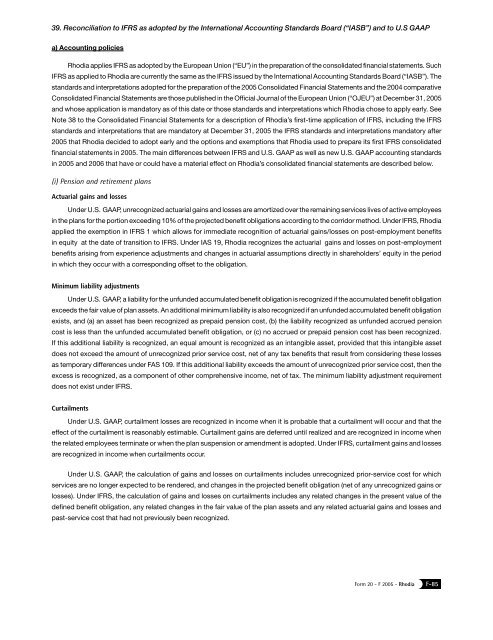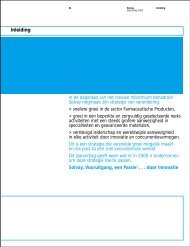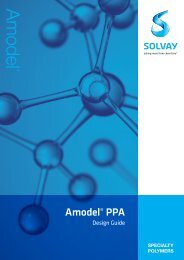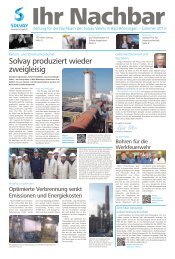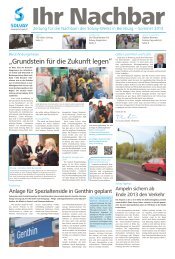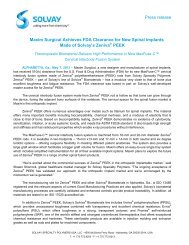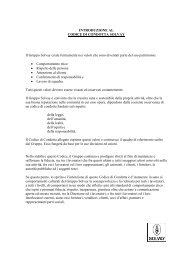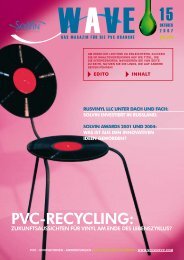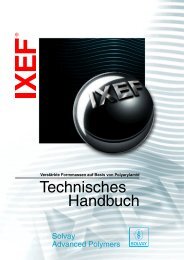Form 20-F 2005
Form 20-F 2005
Form 20-F 2005
You also want an ePaper? Increase the reach of your titles
YUMPU automatically turns print PDFs into web optimized ePapers that Google loves.
39. Reconciliation to IFRS as adopted by the International Accounting Standards Board (“IASB”) and to U.S GAAP<br />
a) Accounting policies<br />
Rhodia applies IFRS as adopted by the European Union (“EU”) in the preparation of the consolidated financial statements. Such<br />
IFRS as applied to Rhodia are currently the same as the IFRS issued by the International Accounting Standards Board (“IASB”). The<br />
standards and interpretations adopted for the preparation of the <strong>20</strong>05 Consolidated Financial Statements and the <strong>20</strong>04 comparative<br />
Consolidated Financial Statements are those published in the Official Journal of the European Union (“OJEU”) at December 31, <strong>20</strong>05<br />
and whose application is mandatory as of this date or those standards and interpretations which Rhodia chose to apply early. See<br />
Note 38 to the Consolidated Financial Statements for a description of Rhodia’s first-time application of IFRS, including the IFRS<br />
standards and interpretations that are mandatory at December 31, <strong>20</strong>05 the IFRS standards and interpretations mandatory after<br />
<strong>20</strong>05 that Rhodia decided to adopt early and the options and exemptions that Rhodia used to prepare its first IFRS consolidated<br />
financial statements in <strong>20</strong>05. The main differences between IFRS and U.S. GAAP as well as new U.S. GAAP accounting standards<br />
in <strong>20</strong>05 and <strong>20</strong>06 that have or could have a material effect on Rhodia’s consolidated financial statements are described below.<br />
(i) Pension and retirement plans<br />
Actuarial gains and losses<br />
Under U.S. GAAP, unrecognized actuarial gains and losses are amortized over the remaining services lives of active employees<br />
in the plans for the portion exceeding 10% of the projected benefit obligations according to the corridor method. Under IFRS, Rhodia<br />
applied the exemption in IFRS 1 which allows for immediate recognition of actuarial gains/losses on post-employment benefits<br />
in equity at the date of transition to IFRS. Under IAS 19, Rhodia recognizes the actuarial gains and losses on post-employment<br />
benefits arising from experience adjustments and changes in actuarial assumptions directly in shareholders’ equity in the period<br />
in which they occur with a corresponding offset to the obligation.<br />
Minimum liability adjustments<br />
Under U.S. GAAP, a liability for the unfunded accumulated benefit obligation is recognized if the accumulated benefit obligation<br />
exceeds the fair value of plan assets. An additional minimum liability is also recognized if an unfunded accumulated benefit obligation<br />
exists, and (a) an asset has been recognized as prepaid pension cost, (b) the liability recognized as unfunded accrued pension<br />
cost is less than the unfunded accumulated benefit obligation, or (c) no accrued or prepaid pension cost has been recognized.<br />
If this additional liability is recognized, an equal amount is recognized as an intangible asset, provided that this intangible asset<br />
does not exceed the amount of unrecognized prior service cost, net of any tax benefits that result from considering these losses<br />
as temporary differences under FAS 109. If this additional liability exceeds the amount of unrecognized prior service cost, then the<br />
excess is recognized, as a component of other comprehensive income, net of tax. The minimum liability adjustment requirement<br />
does not exist under IFRS.<br />
Curtailments<br />
Under U.S. GAAP, curtailment losses are recognized in income when it is probable that a curtailment will occur and that the<br />
effect of the curtailment is reasonably estimable. Curtailment gains are deferred until realized and are recognized in income when<br />
the related employees terminate or when the plan suspension or amendment is adopted. Under IFRS, curtailment gains and losses<br />
are recognized in income when curtailments occur.<br />
Under U.S. GAAP, the calculation of gains and losses on curtailments includes unrecognized prior-service cost for which<br />
services are no longer expected to be rendered, and changes in the projected benefit obligation (net of any unrecognized gains or<br />
losses). Under IFRS, the calculation of gains and losses on curtailments includes any related changes in the present value of the<br />
defined benefit obligation, any related changes in the fair value of the plan assets and any related actuarial gains and losses and<br />
past-service cost that had not previously been recognized.<br />
<strong>Form</strong> <strong>20</strong> - F <strong>20</strong>05 - Rhodia<br />
F-85


